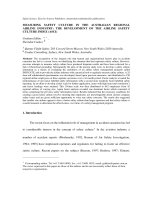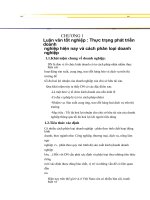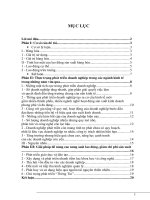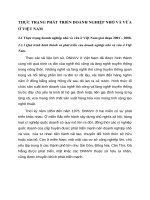Thực trạng phát triển doanh nghiệp hiện nay và cách phân loại doanh nghiệp
Bạn đang xem bản rút gọn của tài liệu. Xem và tải ngay bản đầy đủ của tài liệu tại đây (98.03 KB, 21 trang )
Safety Science, Elsevier Science Publishers, Amsterdam (submitted for publication)
MEASURING SAFETY CULTURE IN THE AUSTRALIAN REGIONAL
AIRLINE INDUSTRY: THE DEVELOPMENT OF THE AIRLINE SAFETY
CULTURE INDEX (ASCI)
Graham Edkins
Α
,
∗
,
Sheridan Coakes
Β
Α
Qantas Flight Safety, 203 Coward Street Mascot, New South Wales 2020 Australia
Β
Coakes Consulting, Sydney, New South Wales, Australia
Abstract- The recognition of the integral role that human and organisational factors play in accident
causation has led to a recent focus on identifying the elements that best represent safety culture. However,
previous attempts to measure safety culture have produced disparate results and have been criticised for a
lack of theoretical grounding. Subsequently the aims of the present study were, to develop a safety culture
instrument as a means of evaluating the usefulness of an airline safety management program called
INDICATE, and to provide the airline industry with a practical tool to regularly measure safety culture. A 25
item self administered questionnaire was developed, based upon previous measures, and distributed to 150
regional airline employees on three separate occasions over a 16 month period. Factor analysis revealed the
predominance of one factor labelled safety information with a second more moderate factor labelled safety
reporting. In an effort to develop a brief scale for further application, items with high item total correlation’s
and factor loadings were retained. This 10-item scale was then distributed to 642 employees from 42
regional airlines of varying size. Again factor analysis revealed one dominant factor which consisted of
items comprising the previous safety information factor. Results indicated that the necessary conditions for
creating a good safety culture involve ensuring that employees are knowledgeable about current company
safety issues and are given sufficient opportunity to voice any safety concerns. The results also suggested
that smaller size airlines appear to have a better safety culture than larger operators and that safety culture is
a useful measure to determine the effectiveness, over time, of a safety management program.
1. Introduction
The recent focus on the influential role of management in accident causation has led
to considerable interest in the concept of safety culture.
1
In the aviation industry a
number of accident reports (Moshansky, 1992; Bureau of Air Safety Investigation,
1994; 1995) have implicated operators and regulators for failing to foster an effective
safety culture. Recent papers on the subject (Reason, 1997; Hudson, 1997; Ginnett,
∗
Corresponding author. Tel: +61 2 9691 8095; fax: + 61 2 9691 8833; email:
The views expressed in this paper are those of the authors and do not necessarily reflect those of their
respective organisations.
1997; Edkins, 1998a) suggest that the establishment of a good safety culture will
encourage safe behaviour and minimise the risk of accident occurrence.
Attempts to more clearly understand the concept of safety culture can be broadly
categorised into two different approaches. The first approach may be called the
industrial view of safety culture, which relies on industry experience and accident
statistics to identify what elements distinguish good from poor safety cultures. The
second approach is more academic and is based on conducting empirical research in an
attempt to develop methods that can measure the concept.
The industrial view of safety culture suggests that the concept involves more than
simply encouraging employees to change their attitudes toward safety. Rather, it is
equally important to implement strategies that motivate employees to gather and assess
potentially dangerous hazards. For example, the International Civil Aviation
Organisation (ICAO, 1992) suggests that a good safety culture is made up of the following
attributes:
• senior management placing a strong emphasis on safety;
• staff having an understanding of hazards within the workplace;
• senior management’s willingness to accept criticism and an openness to opposing
views;
• senior management fostering a climate that encourages feedback;
• emphasise on the importance of communicating relevant safety information;
• the promotion of realistic and workable safety rules; and
• ensuring staff are well educated and trained so that they understand the consequences
of unsafe acts.
1
For the purpose of this article, the term safety culture will be used. However, it should be noted that
safety culture and safety climate are terms that are used interchangeably within the literature and
In the academic arena, there have been many attempts to develop methods to
measure safety culture. However, there is still considerable debate about whether the
concept is generated by specific workplace characteristics or by employee attitudes
about safety (Williamson, Feyer, Cairns & Biancotti, 1997).
The first reported research in the area of safety culture was conducted by Zohar
(1980), who in reviewing the literature and accident rate statistics, attempted to
determine what factors distinguish organisations with good and poor safety
performance. Zohar identified eight factors, and subsequently developed a 49-item
questionnaire to assess safety performance. These factors included: perceived
importance of training programs, perceived management attitudes to safety, perceived
effects of safe conduct on promotion, perceived level of risk within the workplace,
perceived effects of required work pace on safety, perceived status of the safety officer,
perceived effect of safe conduct on social status and perceived status of the safety
committee. Nine items were removed from the original 49-item scale and a revised 40-
item questionnaire was administered to 20 production workers within a number of
different workplaces. The results demonstrated that organisations have quite distinct
safety cultures with two factors being most important for identifying workplace
differences: perceived relevance of safety to job behaviour; and perceived management
attitude to safety.
Since Zohar’s initial work, a number of researchers (Glennon, 1982; Brown and
Holmes, 1986; Dedobbeleer and Beland, 1991; Seppala, 1992; Glendon, Stanton and
Harrison, 1994; Cooper, 1995; DeJoy, Murphy & Gershon, 1995) have developed
additional safety culture instruments. However, results have differed widely on the
number (2-11) and types of factors identified. For example, Dedobbeleer and Beland
discussions with experts in the field suggests that there is very little that distinguishes one from the other.
(1991) identified the following two broad factors: management commitment to safety
and employee involvement in safety. In contrast, Glendon, Stanton and Harrison (1994)
identified eleven factors which are representative of much more specific employee
workplace perceptions such as work pressure, procedures, relationships, investigations
and personal protective equipment.
Other studies (Cox and Cox, 1991; Donald, Cantaer and Chalk, 1991; Niskanen,
1994) utilising attitudinal survey methods have produced disparate results in attempting
to identify the important elements that constitute safety culture. Results have ranged
from three (Donald et al 1991) to four factor solutions for management and employees
(Niskanen, 1994).
According to Williamson et al (1997) two factors appear to be reflected
consistently across the majority of studies undertaken: management attitude toward
safety; and employee involvement and/or attitudes to safety. Despite this finding, no
further agreement exists regarding the dimensions that comprise safety culture.
Niskanen (1994) suggests that this is due, in part, to relatively little cross matching of
data from previous studies and a lack of studies, which base their work on established
theory.
Dissimilar results of this kind are not surprising considering the different aims of
various studies and varying types of response formats used. For example, the work of
Cox and Cox (1991) and Donald et al (1991) was concerned with general employee
attitudes about safety, whereas Brown and Holmes (1986) focused on specific employee
perceptions about the state of safety within a workplace. Various types of scales used
include the visual 9 point analogue scale with descriptors of “never”, “sometimes” or
“always” (Glendon, Stanton and Harrison, 1994), to a combination of 3-5 point likert
scale formats (Zohar, 1980; Dedobbeleer and Beland, 1991).
From the studies reviewed above, it is clear that further safety culture research is
needed to better understand the significant elements that determine this concept. In
addition, discussions with various sectors of the Australian aviation industry suggests
that a practical tool to measure airline safety culture may assist passenger carrying
operators in identifying areas where safety improvements are required (Edkins &
Brown, 1996).
The present research consisted of two studies. The objective of Study 1 was to
develop a safety culture measure as a basis for determining the effectiveness of an
airline safety management program called INDICATE
2
(Edkins, 1998b; 1997). It was
evident at the time of the present study’s design that there was a lack of theoretically
sound and methodologically reliable instruments available to measure safety culture.
Therefore, rather than relying on existing measures, a new instrument was developed
based on the findings of previous research (Cooper, 1995; Dedobbeleer and Beland,
1991; Brown and Holmes, 1986) and from experiences within the aviation industry
(ICAO, 1992). It was hoped that the longitudinal nature of this study would demonstrate
the usefulness of safety culture in measuring the effectiveness of a safety management
program and provide further insights into the dimensions that constitute safety culture
over a sixteen month period.
The objective of Study 2 was to develop a brief, but practical version of the safety
culture instrument so that it could be more easily applied by operators to regularly
monitor a company’s safety culture. Previous research (Williamson et al, 1997) suggests
that safety culture is largely a uni-dimensional concept, therefore a short scale may
provide a more useful and reliable tool in situations where employees have limited time
to complete lengthy questionnaires. Furthermore, in the Australian regional airline
industry, history has consistently demonstrated that it is with smaller operations (e.g.
less than 10 seats) where fatal accidents are more likely to occur. It was expected that
administering the short scale to a number of different size operators within the regional
industry would reveal differences in safety culture among operators of varying size and
that safety culture may also vary across different occupational groups within the
industry.
2. Method - Study 1
2.1 The development of the ASCI
The Airline Safety Culture Index (ASCI) was developed to measure safety culture
specifically within the regional airline industry. The instrument consisted of 25
positively worded statements, each requiring a response on a five point likert scale
ranging from strongly agree to strongly disagree. Based upon a review of previous
research, cited above, items developed were based on the following core dimensions:
management commitment (2 items); management action (6 items); employee
commitment (4 items); level of perceived risk (1 item); beliefs about accident causation
(2 items); emergency procedures (1 item); the provision of safety training (2 items); and
safety communication (7 items). Prior to administering the questionnaire, a draft was
given to 10 safety professionals within the aviation industry with varying backgrounds
ranging from psychology, engineering, air traffic control and pilots from commercial,
military and airline backgrounds. Based on these responses minor modifications were
made to instrument items to improve clarity and comprehension.
2
Identifying Needed Defences In the Civil Aviation Transport Environment.
2.2 The development of the INDICATE safety management program
The INDICATE program is a proactive safety management program, which was
developed specifically for regular public transport (RPT) and aviation charter operators to
improve the way safety hazards are addressed within an airline. The program provides a
simple but structured process to ensure consistent and high quality safety feedback is
regularly communicated to all airline staff. This is achieved through the following six core
safety activities:
1. conducting a series of staff focus groups to proactively identify safety hazards within
the airline;
2. establishing a confidential safety reporting system;
3. conducting monthly safety meetings with management;
4. maintaining a safety information database;
5. electing an operational safety officer who is available to staff as a confidante for safety
related issues; and
6. ensuring that safety information is regularly distributed to all staff.
2.3 Sample and study design
A time series with non-equivalent control group design was used to evaluate the
INDICATE program. Cooperation was gained with a major Australian regional airline
that operates out of two regional centres. The INDICATE program was implemented in
one regional centre (intervention group) for a sixteen month period while the other
regional centre received the program at the eight month stage of the sixteen month trail
(delayed intervention group).
The ASCI was administered on three separate occasion’s to both groups; prior to
the implementation of INDICATE (time 1, pre-intervention); at the eight month stage of
the trial (time 2, post-intervention); and at the end of the sixteen month trail period
(time 3, delayed-intervention).
Time 1, pre-intervention administration
The ASCI was distributed to all 180 employees within the intervention and
delayed intervention groups. Employees within the intervention group were requested to
complete their questionnaire prior to them participating in a safety focus group. The
questionnaire was distributed personally to employees within the delayed intervention
group by the base safety officer. Employees were requested to return the completed
questionnaire in a free post envelope provided. Participants were asked to write a code
on the top right of their questionnaire, so their responses could be matched at times 2
and 3. 153 questionnaires were returned indicating an 85% response rate.
Time 2, post-intervention administration
The post-intervention administration occurred 32 weeks (eight months) after the
pre-intervention. The questionnaires were personally administered to all 180 employees
with a requirement to return it to the base safety officer or mail it to a post office box in
the free post envelope provided. 151 questionnaires could be matched to time 1.









